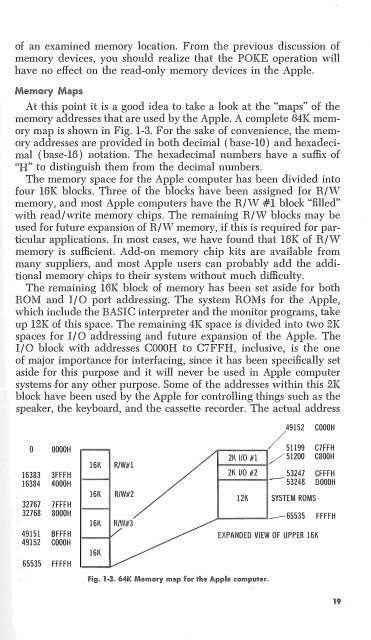You also want an ePaper? Increase the reach of your titles
YUMPU automatically turns print PDFs into web optimized ePapers that Google loves.
of an examined memory location. From the previous discussion of<br />
memory devices, you should realize that the POKE operation will<br />
have no effect on the read-only memory devices in the Apple.<br />
Memory Maps<br />
At this point it is a good idea to take a look at the "maps" of the<br />
memory addresses that are used by the Apple. A complete 64K memory<br />
map is shown in Fig. 1-3. For the sake of convenience, the memory<br />
addresses are provided in both decimal (base-10) and hexadecimal<br />
(base-16) notation. The hexadecimal numbers have a suffix of<br />
"H'' to distinguish them from the decimal numbers.<br />
The memory space for the Apple computer has been divided into<br />
four 16K blocks. Three of the blocks have been assigned for R/W<br />
memory, and most Apple computers have the R/W #1 block "filled"<br />
with read/write memory chips. The remaining R/W blocks may be<br />
used for future expansion of R/W memory, if this is required for particular<br />
applications. In most cases, we have found that 16K of R/W<br />
memory is sufficient. Add-on memory chip kits are available from<br />
many suppliers, and most Apple users can probably add the additional<br />
memory chips to their system without much difficulty.<br />
The remaining 16K block of memory has been set aside for both<br />
ROM and 1/0 port addressing. The system ROMs for the Apple,<br />
which include the BASIC interpreter and the monitor programs, take<br />
up 12K of this space. The remaining 4K space is divided into two 2K<br />
spaces for I/ 0 addressing and future expansion of the Apple. The<br />
I/ 0 block with addresses COOOH to C7FFH, inclusive, is the one<br />
of major importance for <strong>interfacing</strong>, since it has been specifically set<br />
aside for this purpose and it will never be used in Apple computer<br />
systems for any other purpose. Some of the addresses within this 2K<br />
block have been used by the Apple for controlling things such as the<br />
speaker, the keyboard, and the cassette recorder. The actual address<br />
49152 COOOH<br />
0 OOOOH 51199 C7FFH<br />
2K 1/0 #1 /51200 C800H<br />
16K R/W#l<br />
.<br />
16383 3FFFH<br />
2K 110 #2<br />
-<br />
53247 CFFFH<br />
16384 4000H<br />
53243 DOOOH<br />
16K R/W#2<br />
12K SYSTEM ROMS<br />
32767 7FFFH<br />
32768 8000H -65535 FFFFH<br />
16K<br />
49151 BFFFH EXPANDED VIEW OF UPPER 16K<br />
49152 COOOH<br />
65535 FFFFH<br />
16K<br />
Fig. 1-3. 64K Memory map for the Apple computer.<br />
19

















